
| 
|
Not only do these details serve to make Deidre more naturalistic, they play a pivotal role in generating the appropriate emotion cues. The raising and lowering of the eyebrows and the dialation and contraction of the pupils serve to distinguish one emotion from another, while hair has the effect of softening her features. We want to take into consideration our computational processing and memory limitations. More importantly, these components must be aesthetically consistent with our existing facial mesh. A realistic hairstyle may not be appropriate if it may cause other fatures to look even more synthetic by contrast.

| 
|
Ancient Greeks deemed the eyes as the window to the soul; the expressiveness of a face are highly dependent on motion cues from our eyes, eyebrows, eyelids, and even pupils. The eyelids are defined as part of the facial polygonal mesh. We define the eyebrows separately from the facial mesh as portions of a sinusoidal curve, and are rendered as single tubes. The eyes are three parametric spheres. Dilating and contracting the pupil also works as a strong cue for other humans to interpret the expression as positive or negative as seen above. Rotating the eyes downward,upward, or shifting them side to side also dramatically alter the nature of an expression.
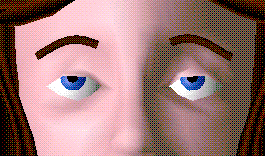 | 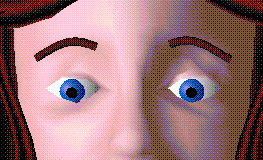
|
We introduce an extremely economic method for hair modeling: multiply curled sheets. Deidre's hairstyle is composed of four curled strips, one for the forelocks, two for the side flanks, and one for the top scalp and back. We texture map the strips to simulate different strands by assigning two separate colors, brown and black in this case, according the horizontal or vertical position of the pixel. The asymmetric part in the forelocks is modeled by the piecewise function,
where (0 < x < 10) and (0 < y < 16), and Lx and Ly are constants.
The other strands are likewise curled with appropriate piecewise sine functions. There is great flexibility for modeling different shapes; more strands will yield more realistic results.
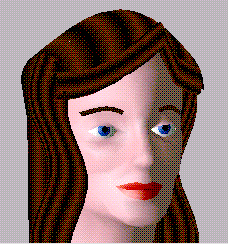
| 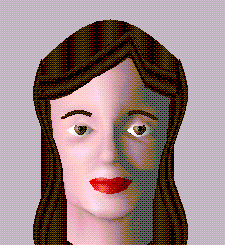
|
Rankin and Hall has introduced the polyline method which renders a great number of random-length lines of subpixel resolution width; these lines are curled with what they term the pseudo-force function. Their method, when enhanced with appropriate coloring and shadowing, approximates a good bushiness for a pony-tail hairstyle.
Although we modeled a set of teeth with rows of deformed cubes, a pseudo tongue modeled with an ellipsoid shaded an appropriate plum color produced more visually pleasing effects. We attribute the difficulty of modeling teeth to the fact that human eyes are highly sensitive to geometric shapes as well as regularities in pattern, thus a more eroded shape and texture for the teeth may be required.
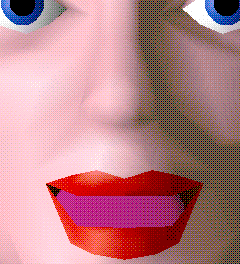
| 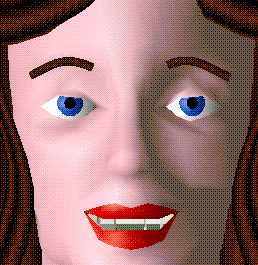
|